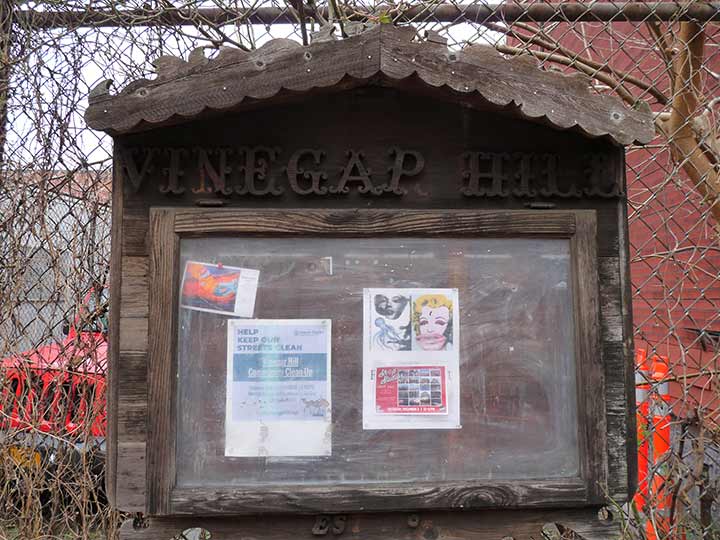
WHAT a surprise it was when, while pedaling around DUMBO on. a bicycle in the 1970s or 1980s, I took off east down Plymouth Street, navigating the Belgian blocked pavement and remaining Jay Street Connecting Railroad tracks. Eventually the brick and stone factory buildings fell away, giving way to a very small batch of tree-lined streets with storefronts (abandoned even then) and residences. The tall-steepled St. Ann’s Church was still there then. I was in the enclave called Vinegar Hill. I don’t think DUMBO was called DUMBO then; it was merely an extension of Downtown Brooklyn. The brick buildings, formerly home to shoe manufacturing, William Gair cardboard box factories and Arbuckle Brothers Yuban Coffee refineries, were then home to small manufacturing. DUMBO has become a bustling residential and business district, and its waterfront makes it a prime tourist locale. On December 31, 2023 I made my first foray into Brooklyn in over a year, as I had been hampered by a hernia and recurring sciatica that I hope won’t recur too often. I wandered DUMBO and Vinegar Hill, and will use the photos here eventually.
Vinegar Hill is about a four or five block square neighborhood located east of DUMBO and north of the Farragut Houses. It’s a charming little area marked by brownstone buildings and Belgian-block streets that haven’t yet been asphalted. Other than a couple of groceries and bodegas on Gold and Bridge Streets, and a couple of haute restaurants on Hudson Avenue, residents have to travel west to Brooklyn Heights, west to DUMBO, or south to Fulton Mall for amenities. It’s all that is left of a rather more extensive residential area; it was gradually decimated by the construction of the nearby Brooklyn-Queens Expressway and the Farragut Houses south of York Street in the 40s and 50s.
The story of how Vinegar Hill got its name is an unusual one. Vinegar Hill has been here since 1800, when a John Jackson purchased its land from the Sands brothers (for whom Sands Street is named). Jackson actually hoped to attract Irish immigrants in an era when Irish were otherwise unwelcome. He named his tract Vinegar Hill after the site of a fierce battle in the unsuccessful Irish rebellion of 1798. In Ireland, the name “Vinegar Hill” was an English transliteration of an Irish Gaelic term meaning “hill of the wood of the berries.” Vinegar Hill has also been known as Irish Town. Most of its residences were built between the late 1820s and the 1850s; the latter ones reflect the Italianate style.
As always, “comment…as you see fit.” I earn a small payment when you click on any ad on the site. Take a look at the new JOBS link in the red toolbar at the top of the page on the desktop version, as I also get a small payment when you view a job via that link.
3/12/24


7 comments
I knew Vinegar Hill was an Irish envlave in the 19th Century. I never vonnected it with the Battle of Vinegar Hill in Ireland. It makes sense! Thanks for this and all the interesting
Information you shate!
There was a licorice factory around there and it sure smelled good.When the women took their break out
on the loading dock I used to try to get some free samples from them but no dice
That may be fortunate if it was black licorice, because you can die from eating too much.
I thought you were repeating an old wives tale, but I Googled it and found this:
“Black licorice contains glycyrrhizic acid, which can cause swelling and high blood pressure and deplete potassium and other electrolytes that may cause a cardiac arrhythmia or arrest.”
You learn something new every day!
The Belgian Blocks won’t ever be asphalted, they are now protected by the Historic DIstrict, although many are being under guard at a facility for when the infrastructure work in the area is completed.
As a child, the neighborhood residents understood the value of the blocks. In the 1980s, on occasion, some asphalt laying company would have extra material and rather than dispose of it properly, they would try to dump it on Hudson Ave. We would all come out and lie on the streets to prevent the material from being laid. Police would even come out. One time a company was immediately ordered by the city to remove and scrap off asphalt they managed to pour down. After having to do that, nobody tried to lay asphalt to cover the stones, and the stones were eventually declared historical and protected by the historic district.
That was just one of many “battles” the residents of the neighborhood had to do to protect the neighborhood.
There was a major one in 1869, when the Military attacked the neighborhood from the Navy Yard under orders by Ulysses S. Grant, and were met by angry residents throwing bottles and bricks at them.
Amazing how much history is in this tiny neighborhood. I grew up here and love living here.
It was known as the Brooklyn Whiskey wars.
https://brooklynancestry.com/brooklyns-whiskey-war-of-1869/
I’ll pick this random moment to thank you Kevin for this site.
I read it almost every day, enjoying the different view of NYC.
It is a very well researched and interesting view of the technology and social changes of a very large city told in small stories.
Thank you.
I ate licorice till I was blue in the face and my tongue was black but no dice.Perhaps I didnt die
because modern licorice is artifically flavored now perhaps?Thats was in 1970 or so so modernization
of licorice was probably well under way by then using up to date manufacturing techniques and
processes heretofore undreamed of by our ancestors in their caves as they carved out a living from
a hostile environment and made do with what little they had in the way of basic tools and materials